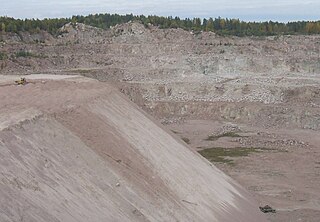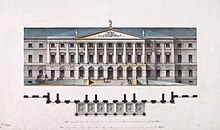
Russia is divided into several types and levels of subdivisions.

Priozersk is a town and the administrative center of Priozersky District in Leningrad Oblast, Russia, located at the northwestern shore of Lake Ladoga, at the estuary of the northern armlet of the Vuoksi River on the Karelian Isthmus. It is served by a station of the same name on the St. Petersburg—Khiytola railway. Population: 18,777 (2021 Census); 18,933 (2010 Census); 20,506 (2002 Census); 20,557 (1989 Soviet census).

Leningrad Oblast is a federal subject of Russia. The oblast has an area of 84,500 square kilometres (32,600 sq mi) and a population of 2,000,997 ; up from 1,716,868 recorded in the 2010 Census. Leningrad Oblast is highly industrialized. Its administrative center and largest city is Gatchina.

Toksovo is an urban locality in Vsevolozhsky District of Leningrad Oblast, Russia, located 20 kilometers (12 mi) to the north of St. Petersburg on the Karelian Isthmus. It is served by two neighboring stations of the Saint Petersburg-Khiytola railroad: Toksovo and Kavgolovo (1929). Population: 6,127 (2010 Census); 5,893 (2002 Census); 5,699 (1989 Soviet census).
Krasny Bor is an urban locality in Tosnensky District of Leningrad Oblast, Russia, located 20 kilometers (12 mi) southeast of the center of St. Petersburg. Population: 5,033 (2010 Census); 4,877 (2002 Census); 5,791 (1989 Soviet census).

Mga is an urban locality in Kirovsky District of Leningrad Oblast, Russia. Population: 10,212 (2010 Census); 9,613 (2002 Census); 9,852 (1989 Soviet census).

Nikolskoye is a town in Tosnensky District of Leningrad Oblast, Russia, located on the Tosna River 40 kilometers (25 mi) southeast of the center of St. Petersburg. Population: 19,280 (2010 Census); 17,309 (2002 Census); 17,215 (1989 Soviet census).

Siversky is an urban locality in Gatchinsky District of Leningrad Oblast, Russia, on the bank of the Oredezh River. Its population was 12,216 (2010 Census); 12,137 (2002 Census); 11,885 (1989 Soviet census).

The Legislative Assembly of Saint Petersburg is the regional parliament of Saint Petersburg, a federal subject of Russia. It was established in 1994, succeeding the Leningrad Council of People Deputies (Lensovet).

Kuznechnoye is an urban locality in the northern part of Priozersky District of Leningrad Oblast, located on the Karelian Isthmus. Population: 4,458 (2010 Census); 4,738 (2002 Census); 5,017 (1989 Soviet census).

Ulyanovka is an urban locality in Tosnensky District of Leningrad Oblast, Russia, located approximately 40 kilometres (25 mi) southeast of the center of Saint Petersburg. Municipally it is incorporated as Ulyanovskoye Urban Settlement, one of the seven urban settlements in the district. Population: 11,601 (2010 Census); 9,244 (2002 Census); 9,595 (1989 Soviet census).
The municipal divisions in Russia, also called municipal formations, are territorial divisions of the Russian Federation which are formally granted the authority to manage local affairs through local self-government. As of January 1, 2020, there are 20,846 municipal divisions in Russia, including 1,673 municipal districts, 635 urban okrugs, and 33 municipal okrugs.
Pavlovo is an urban locality in Kirovsky District of Leningrad Oblast, Russia, located on the left bank of the Neva River, at the mouth of the Mga River, east of Saint Petersburg. Municipally, together with three rural localities, it is incorporated as Pavlovskoye Urban Settlement, one of the eight urban settlements in the district. Population: 3,250 (2010 Census); 3,365 (2002 Census); 3,886 (1989 Soviet census).
Fornosovo is an urban locality in Tosnensky District of Leningrad Oblast, Russia, located on the Khennaya River southeast of the town of Pavlovsk. Municipally it is incorporated as Fornosovskoye Urban Settlement, one of the seven urban settlements in the district. Population: 6,408 (2010 Census); 4,866 (2002 Census); 2,774 (1989 Soviet census).
Bolshaya Izhora is an urban locality in Lomonosovsky District of Leningrad Oblast, Russia, located on the southern shore of the Gulf of Finland. It is adjacent from the west to Saint Petersburg. Population: 3,314 (2010 Census); 3,831 (2002 Census); 3,967 (1989 Soviet census).

Rakhya is an urban locality in Vsevolozhsky District of Leningrad Oblast, Russia, located on the Karelian Isthmus northeast of Saint Petersburg. Municipally it is incorporated as Rakhyinskoye Urban Settlement, one of the eight urban settlements in the district. Population: 3,188 (2010 Census); 3,156 (2002 Census); 3,316 (1989 Soviet census).

Dubrovka is an urban locality in Vsevolozhsky District of Leningrad Oblast, Russia, located on the right bank of the Neva River northeast of Saint Petersburg. Municipally it is incorporated as Dubrovskoye Urban Settlement, one of the eight urban settlements in the district. Population: 6,693 (2010 Census); 5,432 (2002 Census); 6,093 (1989 Soviet census).
Imeni Morozova is an urban locality in Vsevolozhsky District of Leningrad Oblast, Russia, located on the bank of Lake Ladoga by the source of the Neva River, northeast of Saint Petersburg. Municipally it is incorporated as Morozovskoye Urban Settlement, one of the eight urban settlements in the district. Population: 10,873 (2010 Census); 10,677 (2002 Census); 12,347 (1989 Soviet census).

Kuzmolovsky is an urban locality in Vsevolozhsky District of Leningrad Oblast, Russia, located north of the city of Saint Petersburg. Municipally it is incorporated as Kuzmolovskoye Urban Settlement, one of the eight urban settlements in the district. Population: 9,689 (2010 Census); 9,725 (2002 Census); 10,435 (1989 Soviet census).
















